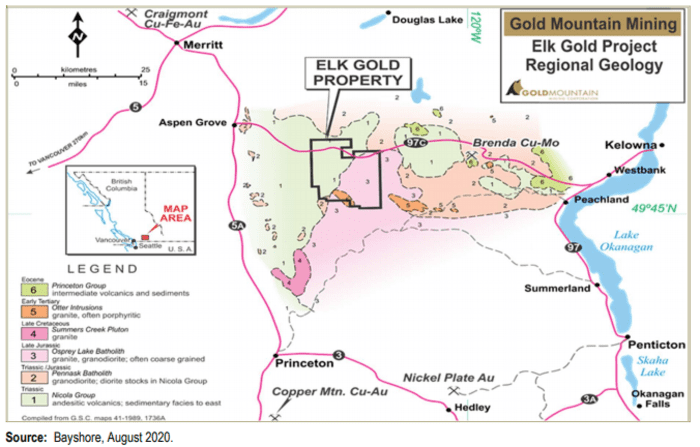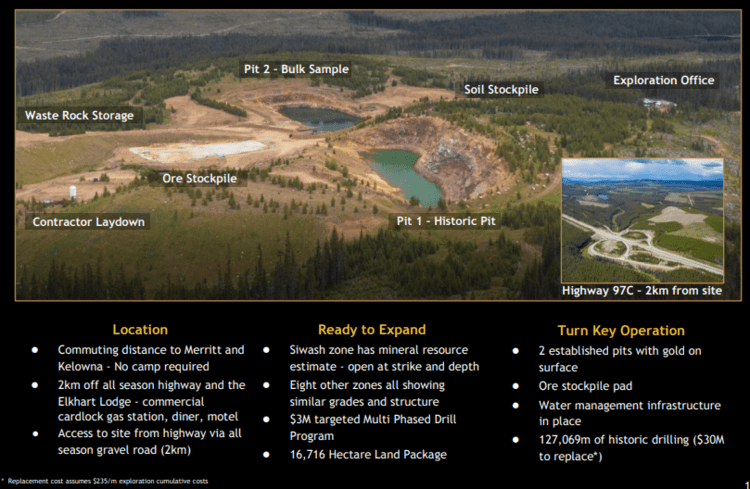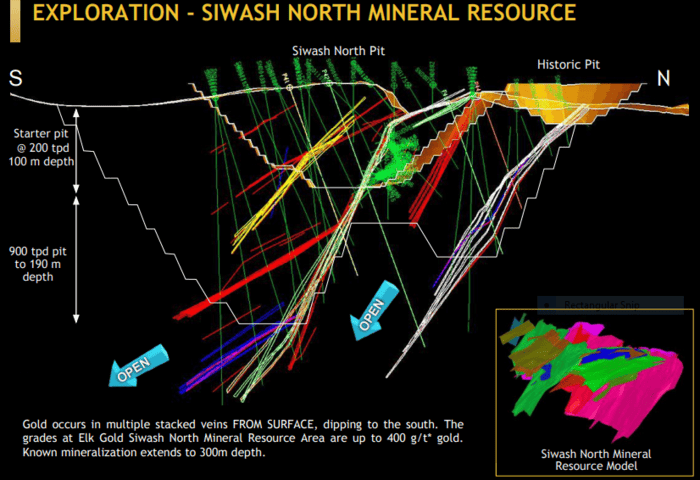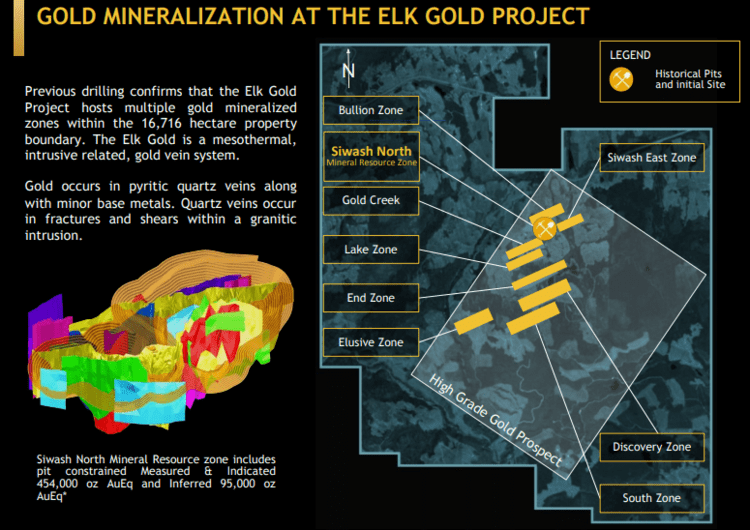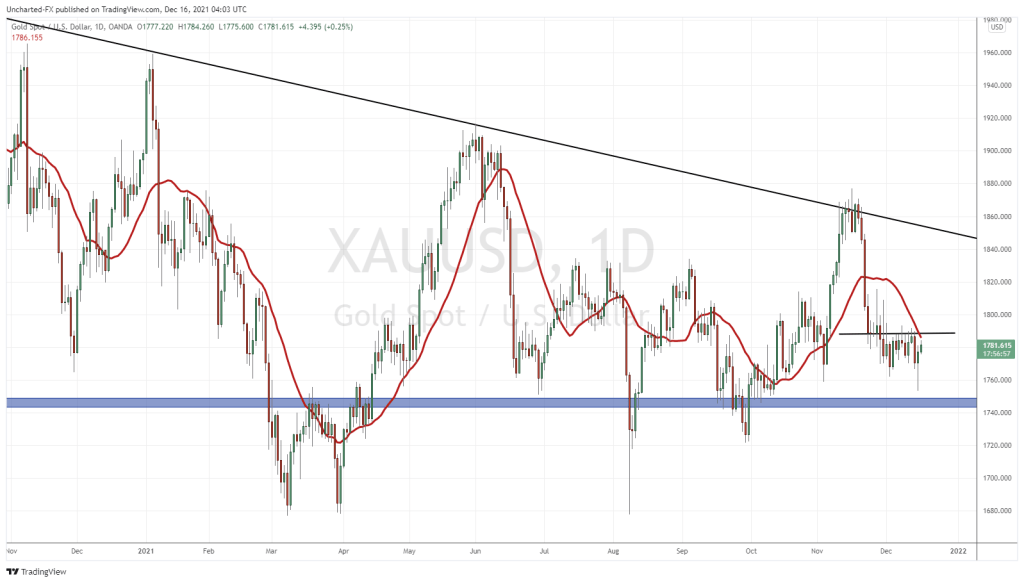Gold Mountain’s (GMTN.V) flagship Elk Gold Project, a historically productive mine located in the heart of B.C. mining country, is being fast-tracked to production. The pace the Company has set for itself fits the “fast track” definition neatly.
Location, always an important consideration when shortlisting buy-candidates in this wild west of a sector, doesn’t get much better than this.
Note the scale on the following map and Elk’s proximity to Merritt and the Okanagan Valley (Hwy 97 cuts right through the northern half of the property).
Quoting Gold Mountain’s CEO, Kevin Smith from earlier this year:
The increase in gold price in 2020 has further highlighted the opportunity outlined in the Elk Gold Project PEA. Last year was about laying the foundation of our plan. This year will be about bringing it to life and delivering on our commitments to our long-term shareholders and supporters.
In our view, this is BC’s next Gold producer.
Focused exploration at the Siwash North Zone generated a modest (pit constrained) resource—an ounce-count that currently stands at 454,000 ounces in the measured and indicated category, and 95,000 in the inferred category.
Siwash North’s grade at 5.33 AuEq ounces per tonne is impressive for an open-pit scenario. And this has generated some compelling economics by way of a first pass economic study—a PEA tabled in September of 2020:
- A Post-Tax NPV of $191M (@ a 5% discount rate);
- A low OPEX – AISC of US$735 per oz;
- A low start-up CAPEX of CA$6.9M;
- An expansion CAPEX of CA$26M once the Company decides to scale the project;
- A 50,000 ounce per year mine plan by Year 4;
- A payback period of 6 months, from the start of production.
This wholly-owned 16,716-hectare chunk of highly prospective terra firma is turn-key. Two established pits boasting shallow mineralization are positioned within a stone’s throw of one another. A strategically positioned pad is close and easily accessed to stockpile ore. All the H2O infrastructure required to run a mine is in place. Logging roads run through the property (note the clear-cuts flanking the project to the north – map below).
We’ve been watching intently from the sidelines as the Company builds momentum in its push along the development curve. Progress is being made on multiple fronts.
On January 9th of this year, the Company signed a mining contract with Nhwelmen-Lake LP.
A few weeks later, the Company engaged a world-class toll milling partner—New Gold—adding validity to the “fast track” plan.
These recent advancements prompted the Company to engage JDS Energy & Mining to complete a pre-feasibility study (PFS), merging these recent milestones into a new mine plan.
This PFS will generate the near-term cost certainty required to delineate a maiden reserve for the Elk project, as well as update the current resource at Siwash North (data-points gained via on-going drilling).
Further up the page, I characterized the current Elk resource as “modest”. The Company has set out to augment that ounce-count with an aggressive Phase-1 drilling campaign. This will be followed by an equally aggressive Phase-2.
On March 11th we got our first look at the values being pulled from Elk’s subsurface layers where current drilling is designed to expand the strike of known mineralized zones beyond the current resource model.
Drill hole highlights from the March 11th press release:
- SND20-004 intercepted 1.5 meters averaging 7.3 g/t Au (including 0.30m averaging 21.7 g/t Au);
- SND20-001 intercepted 1.3 meters averaging 7.2 g/t Au (including 0.30m averaging 30.5 g/t Au);
- SND20-020 intercepted 1.3 meters averaging 5.1 g/t Au (including 0.30m averaging 22.1 g/t Au).
The following slide is a good one—the blue arrows point deeper, and for good reason.
The Company has recently completed approximately 4,250m of core drilling in 26 holes. Phase 1 drilling is planned to encompass a total of 7,100m. Initial holes completed as part of the Phase 1 program were designed to incrementally step out and infill along near surface extensions of known mineralized zones. Initial assay results confirm the Company’s exploration model with the 2600 and 2700 veins intercepted on approximately 75 meter centres over a strike length of 300 meters and 175 meters down dip. This results in a demonstration of connection between the Yellow Brick Road Zone and the Siwash North Zone.
With over 127 kilometers of historic drilling, the Company launched a core re-logging campaign that is using the latest technology to home in on additional veins missed by previous operators. That effort is already paying off—a new vein presented itself in this historic core, one which yielded 1.2 meters averaging 52.3 g/t Au (including 0.30m averaging 216 g/t Au).
Though visual assays are a highly subjective read, even for the more skilled geological sleuths in the sector, the Company stated the following regarding drill core pulled from potential depth extensions of the main resource block:
Phase 1 drilling includes nine (9) holes totalling approximately 2,850m targeting down dip high-grade extensions of the 1300 and 2500 veins below the current lower extent of the resource model in areas that display robust gold grades. Visual observations thus far indicate strong sulphide vein intercepts in these holes. The Company anticipates that upcoming assay results from the 1300 and 2500 veins will help JDS Mining better determine the feasibility of underground mining.
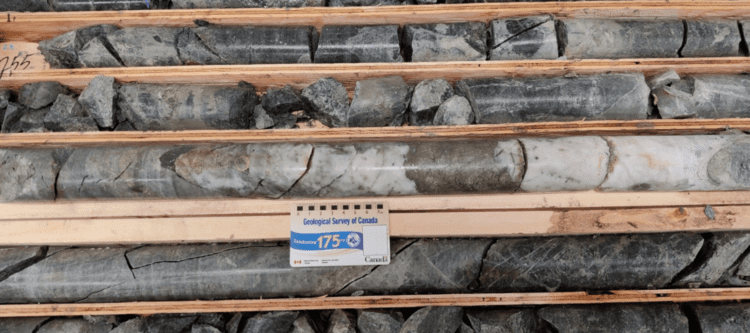
Tying these speculative elements together, CEO Smith stated the following:
“Management has a goal of driving this resource to a million ounces and beyond. We plan to accelerate our relogging program, given the newly discovered 216 g/t intercept, and commence Phase 2 of our drill program as soon as Phase 1 is complete. Initial drill results are validating our thesis that gold mineralization can be predictably expanded at the Elk Gold Project. Having built a detailed geologic model utilizing over 127,000m of historic drillhole data, we are able to focus our drilling to add ounces in a cost-effective manner. The drill is now targeting high-grade zones below the current resource, and we’re encouraged by visual indications to date.”
Assays are pending for these deeper holes.
Deeper we go
In the early morning hours of March 22nd, the Company dropped the following headline…
JDS Mining & Energy Inc. to Study the Potential of Underground Mining at the Elk Gold Project
Here, the Company states that the PFS highlighted further up the page will now include a component that examines this latent potential at depth.
CEO Smith:
“Our ability to demonstrate resource and mine plan scalability has been a recurring theme in our conversations with institutional investors. With recent drilling encountering deeper vein extensions and JDS’s trade-off study recognizing a case for transitioning to a potential open pit-underground hybrid mine plan, a very clear path is forming to showcase the Elk Gold Project’s long-term expansion potential from both a resource and production perspective. Over 118,000 ounces of our richest mineralization is beneath the current PEA pit shell. This latest underground concept allows us to consider those well-defined ounces and reduce the project’s overall strip ratio to continue chasing the deep, high-grade mineralization at the Elk“.
Pure speculation on my part, but the Company geos must really like the core they’re pulling from the 1300 and 2500 veins down dip (assays are pending).
New hire (Company Advisor), Dr. Quinton Hennigh:
“When I reviewed the Elk Gold Project a few years ago, it was clear that the mineralization improved at depth. Developing an underground scenario was something that I encouraged management to consider during our initial conversations. After conducting a number of trade-off studies, JDS has concluded it is worthy to undertake a study of an underground mine plan to complement the open-pit scenario. This adds a new exciting dimension to the Elk Gold Project and I look forward to working with Gold Mountain’s technical team to continue maximizing the value of this high-grade asset.”
All of these recent developments center on the main resource block at the Siwash North Zone where 7,150 meters are slated for this Phase-1 campaign… but there’s heaps of blue sky elsewhere along Elk’s subsurface stratum.
There are eight additional (known) mineralized zones, all showing similar grades and structure.
And the Company intends to give these zones a proper probe with the drill bit during a Phase-2 campaign, scheduled to follow-up fast once Phase-1 is done.
Examples:
- The Gold Creek Zone will see 3,250 meters of drilling.
- The South Zone will see 2,475 meters.
- The Lake Zone will see 750 meters.
- The Elusive Zone will see 750 meters.
Final thoughts
The team behind this near-term production play is top shelf with a solid track record of creating shareholder value. Insiders own 25% of the outstanding common.
Assay-related newsflow may dominate the short term, but an updated resource estimate, permitting news, and progress updates on the development front are all on deck. All represent potential price catalysts going forward.
END
—Greg Nolan
Full disclosure: Gold Mountain is an Equity Guru marketing client.


